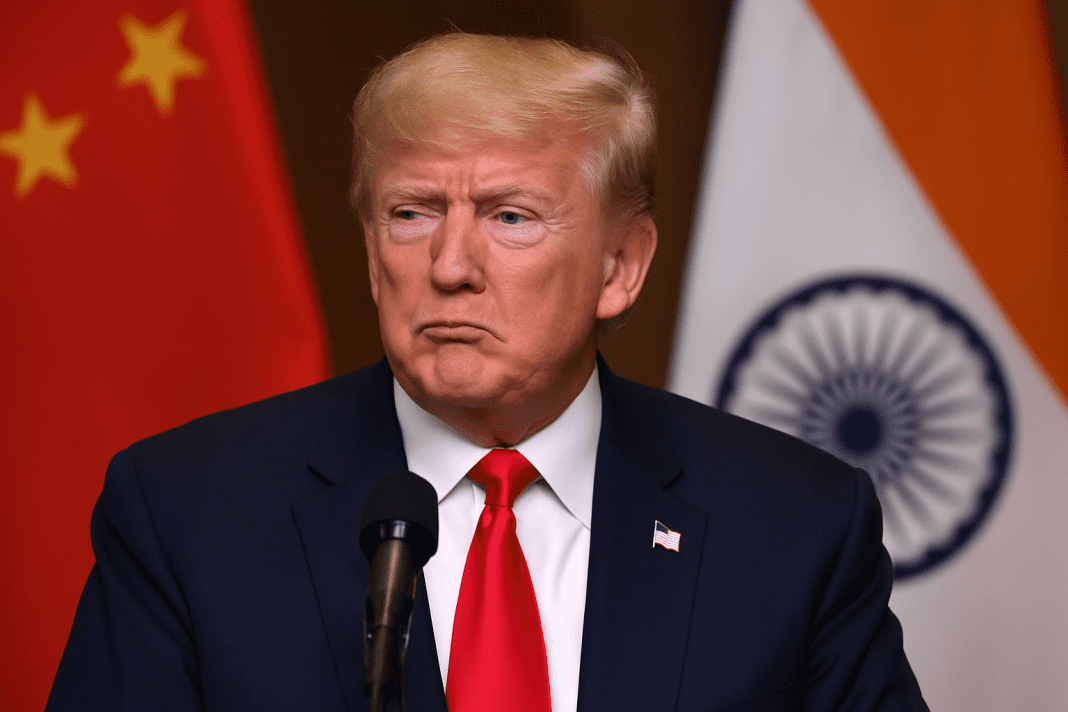In 2025, Donald Trump returned to the White House, promising to fix America’s trade problems with China through a tougher trade war strategy. However, just six months into office, things have taken a dramatic turn. Instead of going after China, Trump is now targeting India — one of America’s strategic partners for the last two decades.
This sudden change has surprised many in Washington. For years, both Democratic and Republican governments supported stronger ties with India. India joined the QUAD group with the US, Japan, and Australia. It also moved closer to Western alliances in defense and security.
Trump Turns from Beijing to Delhi in New Trade War Twist
Now, all that seems to be at risk. Trump recently placed a 25% tariff on Indian goods and threatened to raise tariffs on Indian pharmaceutical products to as high as 250%. These moves have shocked policy experts, especially since Trump is not placing the same level of pressure on China — a country with a much bigger role in the ongoing trade war.
According to Evan A. Feigenbaum, a former senior US official on South Asia policy, Trump is damaging a carefully built relationship. Writing for the Carnegie Endowment, he warned that Trump is undoing over 20 years of work that brought Washington and New Delhi closer.
In an interview with CNBC, Trump justified the new tariffs by claiming he wants pharmaceuticals to be made in the US. He said, “We’ll be putting (an) initially small tariff on pharmaceuticals, but in one year, one-and-a-half years, maximum, it’s going to go to 150 percent, and then it’s going to go to 250 percent.”
Markets Plunge as US Escalates Trade War with Mexico, Canada, and China!
In contrast, Trump had earlier warned China of a 145% tariff if trade talks failed. But now, China seems to be escaping harsh penalties — even though it’s responsible for a larger share of US trade issues and is a major buyer of Russian energy.
India Targeted Despite Lower Deficit Amid Trade War Pressures
The numbers tell a clear story. In 2024, the United States had a huge trade deficit with both China and India — but the gap with China was far greater.
The US exported $143.5 billion in goods to China but imported $439 billion in return, resulting in a $295 billion deficit. In comparison, the trade deficit with India was just $46 billion — nearly six times smaller.
Yet, it is India that now faces steep tariffs and public criticism. Trump has repeatedly said that India is buying too much oil from Russia. However, the data shows that China is the number one buyer of Russian oil — not India.
According to the Center for Research on Energy and Clean Air (CERA), from December 2022 to June 2025, China bought 47% of all Russian crude oil exports. India came second with 38%, followed by the European Union and Turkiye with just 6% each.
When it comes to coal, the pattern is similar. China bought 44% of Russian coal exports during the same period. India’s share was only 19%. Others like Turkiye, South Korea, and Taiwan made up smaller portions.
Even in liquefied natural gas (LNG), the EU was the top buyer — not China or India. The EU bought 51% of Russia’s LNG, while China and Japan followed with 21% and 18% respectively.
The trade war between the US and its global partners is now pulling India into the crossfire. Despite being a long-standing ally, India is being treated more harshly than China. Former US presidential candidate Nikki Haley also questioned this imbalance, writing on social media, “Don’t give China a pass and burn a relationship with a strong ally like India.”
India’s role in the trade war has been smaller, but it’s now at the center of Trump’s tariff threats.
China’s Rare Earth Grip Weakens US Defense
China controls nearly 90% of the world’s rare earth materials — special minerals used in military weapons, vehicles, and electronics. These include things like magnets used in fighter jets, parts for night-vision equipment, and components in missiles.
Earlier this year, when Trump threatened China with a 145% tariff, Beijing hit back by cutting exports of these critical minerals. This caused delays and higher prices in the US defense industry.
In response, Trump lowered the tariffs to just 30%, and China restored some of the mineral supply. But the flow of these materials is still tightly controlled by Beijing.
According to a report by The Wall Street Journal, US defense companies are already suffering. One drone manufacturer had to delay deliveries for two months because it couldn’t find magnets that didn’t come from China. Another defense contractor had to pay 60 times the normal price to get samarium — a rare earth metal needed for jet engines.
The report also mentioned that more than 80,000 defense parts used by the US military rely on materials now restricted by China.
Other materials blocked by Beijing include germanium, gallium, and antimony — all used in bullets, sensors, and night-vision devices. These export bans have already led to production slowdowns.
Lutnick Warns India: Trade Talks Can Wait—Stop Backing BRICS and Russian Arms First
Leonardo DRS, a major US defense company, has said it is now using its last reserves of germanium. The Pentagon has taken steps to reduce dependence on China, but experts believe it could take years to fix the problem.
The trade war has now expanded beyond goods to critical materials. With China’s control over rare earths giving it the upper hand, the US seems to be pulling back — not from the trade war itself — but from punishing China too hard. Meanwhile, India is left to face the brunt of new trade penalties.
In total, this ongoing trade war is now less about correcting trade deficits and more about geopolitical pressure points — with China using minerals as leverage and India becoming a convenient target.

